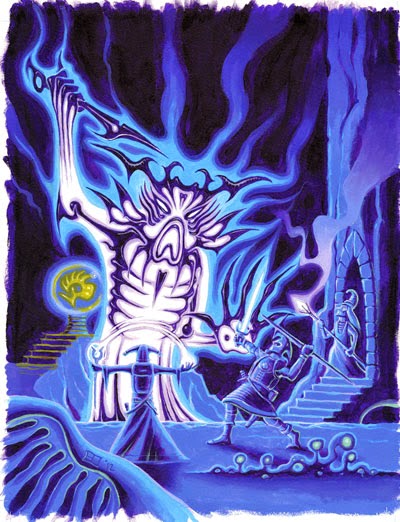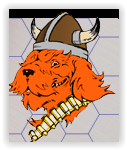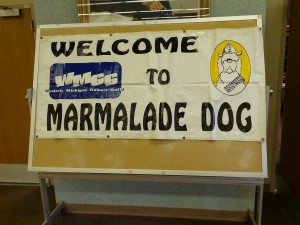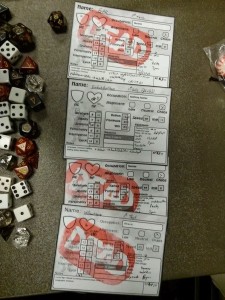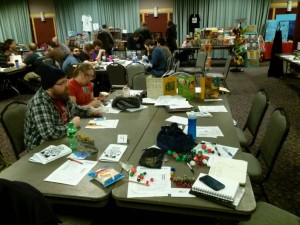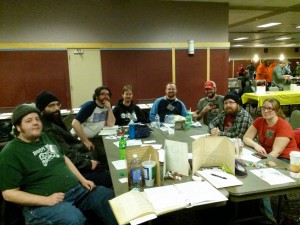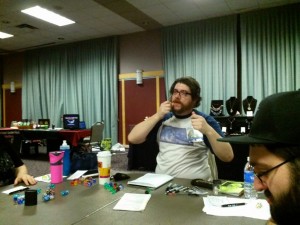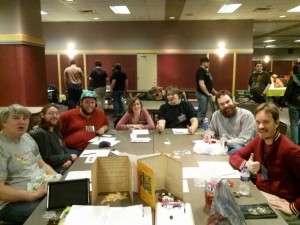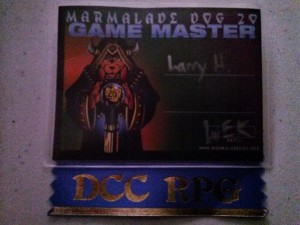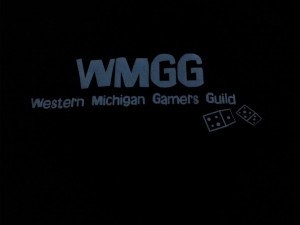White Star: White Box Science Fiction Roleplaying, by +James Spahn of Barrel Rider Games is all the rage at the moment. It has a vibrant and rapidly expanding G+ Community. It also has its own compatibility logo!
Appropriately enough, it was released on May 4th, for Star Wars Day.
I am a big science fiction fan and my first love in reading was science fiction over fantasy. I have played Metamorphosis Alpha, Gamma World, Star Frontiers, Traveller, plus various board games such as Imperium, and several video games. I tended to be the one who ran Metamorphosis Alpha and Gamma World, to give my brother a break from DMing AD&D.
However, my days of playing/GMing science fiction RPGs faded and have not revived like fantasy based RPGs, like AD&D or recently DCC.
I recently bought the Metamorphosis Alpha PDF and printed it out and read it through, with plans of making my own version of the starship Warden, perhaps for a Roll20 campaign.
All the hoopla about White Star is contagious, and I bought the PDF.
I had plenty of interruptions trying to read the PDF. This whole working for a living thing interferes with all my fun.
The art, maps, and layout make it easy to read. The system is designed to be totally compatible with Swords & Wizardry White Box, so any creature or item can easily traverse the two genres. Like the AD&D DMG discussion of combining Gamma World and AD&D, or Boot Hill and AD&D.
The original six standard abilities and 3d6 make it quick to pick up and play.
Rules are presented with a framework, and a clear Rule 0 reference that the Referee can make any changes they want to games in their world.
If you need a lizard man/reptile man in space, you have them stated in Sword & Wizardry already. Take any creature and “re-skin” it by changing its description, and any creature found in S&W is ready to go in White Star.
That is one powerful thing about all the clones and play alikes in the OSR. I have not specifically played Swords & Wizardry, but I “get” it, and since I am used to it, it will not require a lot of effort to run it.
I like how ship to ship combat is a simple abstraction from regular melee combat, with AC, HP, etc. for ships. While certain details are nice, I know that some SF RPG’s are so “crunchy” with rules for every little thing, that the rules get in the way of moving on. Combat can take way too long even in some “rules lite” systems. I’ll have to whip up a couple ships and have them fight it out.
The rules as presented are a sufficient framework to get playing quickly. This framework is familiar to so many, that it is easy to add house rules, ideas from other games, genres, etc., that one can make White Star their own.
Any SF sub-genre could be crafted with this, a generation ship scenario like Metamorphosis Alpha, post apocalyptic like Gamma World, space opera, exploration, war, space pirates, etc.
Race As Class
One thing that others complained about, and I didn’t like at first, until I thought about it, is race as class. In most fantasy worlds with retro-clones or AD&D, demi-humans have level caps. I don’t like that. Also with OD&D clones, there is race as class. I don’t like all aspects of that in fantasy, or in Science Fiction, but I see it making sense in a planet hopping scenario.
If the humans are the dominant group and the “aliens” are tagging along, the level limits will exist because the aliens don’t fit well into the culture, architecture, and design of the human controlled worlds, buildings, and ships. When a handful of aliens are among a huge number of humans, their uniqueness only gives them so many advantages. The hindrances of being surrounded by human sized items, furniture, doorways, etc. will limit how well they can improve their skills among humans. For example, a creature that breathes methane will require special equipment to travel with humans. For aliens that are humanoid to the point of being indistinguishable from humans apart from outward appearance and interior biology, such limits would not be as severe. A ten foot tall alien, however, would have major limitations on space travel.
If the situation is reversed, where a few humans are among a bunch of aliens, surrounded by alien technology, then the humans would have the same issues. I can see someone building a campaign where the humans are a tiny minority in a vast alien empire. If the humans have to have special equipment to breathe while travelling on a ship, it will limit how well and how long they can function outside any special accommodations on the ship added for humans.
Non-humans on their home planet would have advantages that humans would not have.
Humans could have variations leading to sub-species, such as those who inhabited a high gravity planet and get a bonus on their strength when on lower gravity planets and ships.
Rule 0 trumps race as class. If you don’t like it, don’t use it. Problem solved.
Forget Rule 0, There’s A Problem
One minor thing is buying bullets for firearms in preloaded magazines. I don’t know why that minor lack of verisimilitude bugs me. Handgun ammunition is usually available in boxes of 50 and shotgun and rifle ammunition is often in boxes of 20. Detachable magazines are usually reusable. In fact, I am not aware of any firearm for which magazines are not reusable. Of course, Rule 0 and all.
High tech firearms in the universe could be different. People are separated from manual drudge labor, to the point of not having to load magazines. What do you do with the empty one? Turn them in for a magazine deposit? Like bottle deposits in Michigan?
Also a pistol with ten rounds – is it small and easily concealable, or bigger and harder to disguise? Is it ball ammo, hollow point, etc? Can I rack the slide to chamber a round and drop the magazine and top it off to carry 11 rounds? It is all too easy to get hung up on little details and need a rule for it. There is always something that we know from our personal experience that makes it seem like a good idea to add complexity to handle it. Rule 0 still accommodates this. If I really wanted to get down to it, I could build rules for different calibers, revolvers vs. semi-automatics, hollow points vs. ball, ceramic/metal/polymer/combination, breech loaders vs. muzzle loaders, etc.
I don’t have a problem with how computers and other technology is presented in games, so why should this bother me? For example, I know a lot about computers, but their functions are so abstract in the internals and have changed so much since the first computer my parents bought in the early 1980’s that I can handle computers being small and powerful with interfaces much simpler than today. The whole touchscreen “revolution” has changed a great deal about interacting with computers. Voice recognition is better and primitive voice interfaces exist with smart phones, such as, the well-known Siri for the iPhone. The whole exposure to the idea of computers in movies, TV, and the written word have shaped our thinking to allow the devices we use every day to still hold some mystery that makes it easy to ascribe special powers to them.
Aliens & Creatures
Chapter eight on creatures leads with an explanation that specific details about color, activity, and diet is left to the Referee so that their imagination is not restricted.
There are a great many aliens and creatures to fill all the desired tropes of science fiction.
Campaigns
There are several ideas for types of campaigns, plus a campaign based in the Kelron Sector.
Adventure
There is a short sample adventure at the end to get things started. It is an interesting scenario with many familiar ideas from multiple movies, TV shows, books, and stories.
Art
The artwork of the cover and interior is awesome. Maps by Matt Jackson are cool too!
Ideas
Even if you don’t specifically play these rules, there are ideas in here that can be used in any variety of science fiction and other genres of RPG’s.
Editing
There are a few oddities in the flow of words and a few misplaced commas, and some other minor things. If you plan to print this out, I would wait for the update to the PDF. These errors increase towards the end.
I think that I will buy this in print, hopefully the textual issues are resolved quickly.
Other than the few issues in the text, the layout is well done, and it is easy on the eyes.
Other
I let my reading this jump ahead of reading and reviewing the White Box Omnibus also by James Spahn, that I won on the Happy Jacks Podcast for Swords & Wizardry Appreciation Day.
I have heard good things and after reading White Star, I am sure I will find something good!


